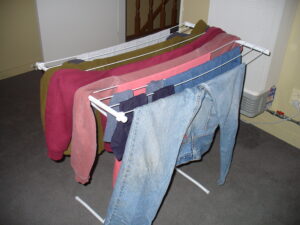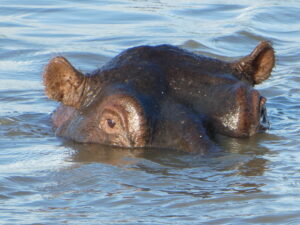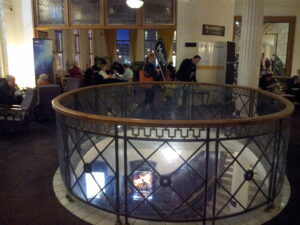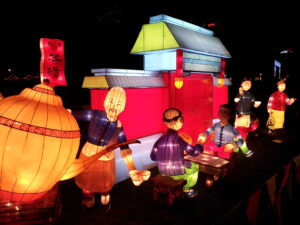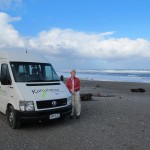
The view was just what we wanted on our trip to the west coast of New Zealand’s South Island: a sweeping panorama of the shoreline with a craggy rock formation to our right. We had pulled up our campervan on the sand parallel to the shoreline and watched the turbulent waves tumbling onto the beach.
One other van was nearby so we weren’t overly concerned about pulling up on what seemed to be a firm section of sand, trying to avoid any soft spots. A bit later, however, rain began to fall.

The weather is fitful here particularly in the spring. One moment the sun disperses the clouds and blue shines through, a few minutes later violent winds whip past you, then it starts sprinkling rain as a mammoth granite colored cloud slides overhead fomented by the ocean far off shore, and after a few minutes more it is joined by other rainclouds clustering together, pouring water down.
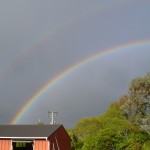
Twenty minutes later the cycle seems to begin again. A few kilometers away and you’re in a different phase of the cycle.
So with the delicate tapping of rain on the roof of the campervan, we reflected on our location a bit more. How soft would the sand beneath us be after all this rain? And, for that matter, how close to us would the waves reach? We realized that we had settled here during low tide but, we confidently observed, the dry sand we were on seemed about 15-20 feet away from the smoothed wet sand that marked the smoothng action of the tides.
We admit we’re novices about caravanning. We had already been travelling a couple of days and nights in our 23 foot long, 6400 pound, VW camper. Barry had the driving duties and, after a few hundred kilometers behind the wheel, got pretty comfortable maneuvering the beast about, avoiding getting too close to the shoulder of the road, and only occasionally stalling out the manual transmission. At night we had stayed at the very organized and well-outfitted holiday parks, the fancy term for mobile home sites for journeying tourists.
There, for $25 and up, you get a comfy flat spot to settle on and the three basic amenities you need: power to supply heat in the night, water to refill your onboard tank, and internet access for modern connecteds. You also get access to their own showers, toilets and common kitchens, but those seem a bit superfluous when you carry your own version of those with you. One place we stayed seemed filled with people even older than we are, veterans of mobile home travel who appeared to be set up for a long stay with porch-like canopies and attached cars. The other was all transients, settled in by night and gone by 10 the next morning.
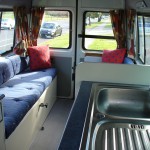
Those two nights had given us the chance to figure out how to work within the van’s comfortable but confined space: where to stow your gear and keep it both accessible as well as anchored down on the highway, how to operate gizmos like the stove and the toilet, how to make and unmake the bed out of the benches in the rear, and so on. In just two days, we had our routine down pretty well, so we were comfortable enough to try some “freedom camping.” We could do without internet overnight, had enough water for two or three days and the weather was chilly, but not so cold as to require heat.
But where to go? We had thought that you could pretty much set yourself down anywhere, like on a beach or at a park. In practice, you find a lot of restrictions introduced because of abuses by too many of the ubiquitous campervans that migrate up and down the coast here throughout the year. Freedom camping is not quite so free as a result. As helpful folks at the i-Site info center informed us, there are supermarket or similar parking lots that allow overnight stays, though for us that would be the very last option. Each town council sets its own rules as well, though most exclude nesting your van on city streets. Also excluded are private property, places marked as no camping, and anywhere near holiday parks who want your business. Plus, in all these spots, you need to be euphemistically “self -contained, ” i.e. you had a toilet onboard.
In the small towns along the west coast, the i-Sites will also clue you in on some nice spots for freedom camping, like Department of Conservation (DOC) sites or the beach we pulled onto.

Those two days had also given us the chance to visit some of the wonderful natural delights of the northern part of the south island. Nancy had researched the options thoroughly so we could decide where to go and how long to stay at various points.
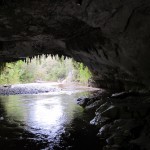
At the north end of the road, in Karamea, we rented a car (for the side road not recommended to campervans) to drive about 45 minutes into the woods so we could hike four hours in the Oparara river basin. There we saw a pair of huge natural arches the river had tunneled out of limestone and an eerily still mirror lake, or tarn.

The circular lake about three football fields across was undisturbed by any wisp of wind. Except for a few ripples stirred by droplets from overhanging branches, it perfectly mirrored the surrounding woods. We tossed a small rock into it, and the ripples spread evenly and slowly outward in perfect circles until they rested on the shore.
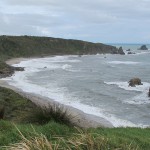
To the south, outside of Westport, we had trekked a couple of hours along the thrillingly jagged rocky coast, up and down the headlands, from the lighthouse at Cape Foulwind (named by Captain Cook in the 1700s) to pyramidal rocky islands and coastal outcroppings where seals made their homes and gulls and white fronted terns roosted.
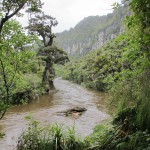
Our freedom camping venture on the beach was in the vicinity of Punakaiki. The day after our beach sleepover, we hiked for three hours along the Porirua River, opposite its vertiginous limestone escarpments and through moist rainforest back over one of its ridges. And we viewed the main tourist attraction, the blowholes and pancake rocks. For video, see the end of this post.
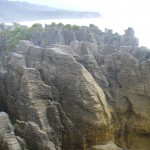
We had already seen the relentless, powerful waves from the beach of course. But at the blowholes, sea level caverns and narrow passages drilled out of the limestone cliffs by the tides, we felt their power.
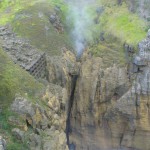
Here odd shapes and carvings a bit like those in Bryce Canyon, Arizona, squeeze blasts of water and booming noise from the onrushing waves at high tide. In one spot, the spray is thrust up hundreds of feet to shower visitors; in another, it’s expelled like a locomotive’s steam engine even higher. The limestone formations are mostly pancaked, appearing like layers of slate stacked upon each other in dense cadres of stalagmites.

On all three days, we were fortunate to have long hours of pleasant and occasionally sunny weather during our hikes, with the worst rain reserved for nights and other hours.
And we were mostly fortunate on our first night of freedom camping. The high tide, which we observed in progress every few hours during the night when one of us awoke, stayed 20 feet away at its farthest reach, though in the glittering moonlight it looked all but upon us. In the morning, the sand seemed no softer than the previous evening despite all the rain.
As we backed out of the spot, however, we misjudged where to go and ended up stuck in squishy sand, the rear wheels spinning fruitlessly. We applied our admittedly limited experience in extracting weighty caravans, or any other vehicle for that matter, out of sandy holes, and found some assistance from the pleasant German couple in the neighboring campervan. Sticks, stones and some digging got the beast to move forward close to our starting point, but it got stuck again. The cold morning wind off the water whipped around; a biting mist began to drive into our faces.
Then the experts arrived, as if sent by some Kiwi angel. A New Zealand family visiting out of Christchurch just happened by to walk the beach. “These campervans are not made for sand like this, you know.” We knew, by then. But the couple – in a friendliness so common to people here – took the time to help us dig out a flat ramp for the tires to smooth the way, lay down a short road bed of seaweed and straw-like debris, and lastly added muscle to help get the beast going. With a heave, an accelerating thrust in reverse, and a progressively carved turn, within a few seconds the carvan veered back onto solid ground. An hour after we were stuck, we were freed from the slippery sand of our freedom campsite. Cheers and hugs and thank yous followed, before our angels departed as suddenly as they had arrived. And we were free to enjoy the day’s hike and Punakaiki blowholes.
Where to spend the next night? Freedom camping at the same beach, of course, but firmly on solid ground.
(Recommendation: Top 10 Holiday Parks for overnight cottages or campervan sites; RoadAbode/Kahurangi Motor Homes in Nelson for campervans. And for more pictures from New Zealand, CLICK HERE to view the slideshow at the end of the New Zealand itinerary page.)
Video 1 of 2: Blowhole/chimney at Punakaiki
Video 2 of 2: Blowhole & Pancake Rocks at Punakaiki



